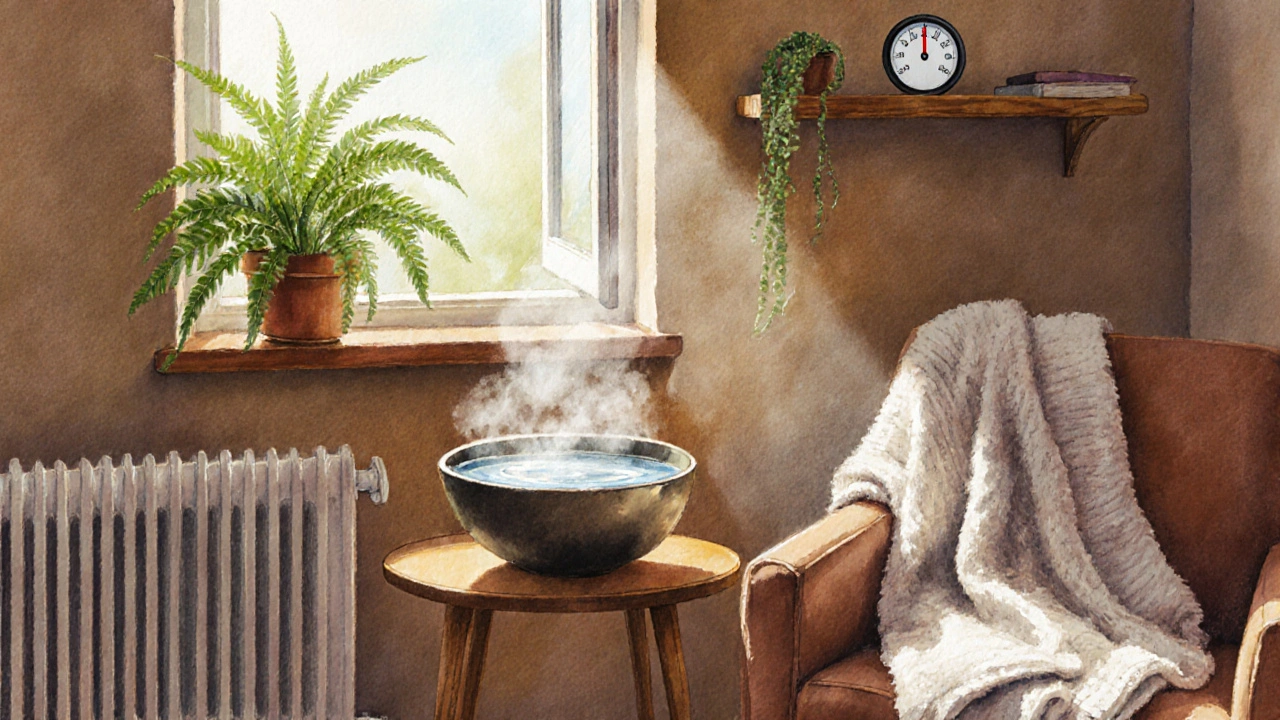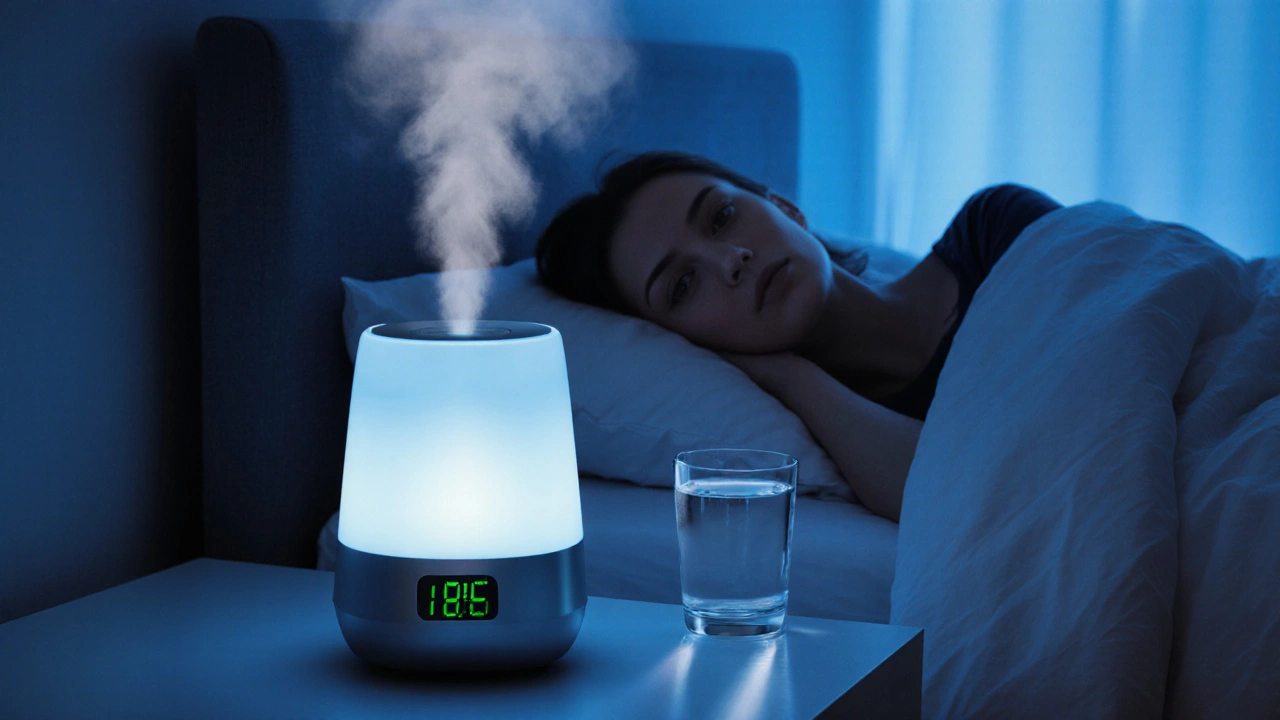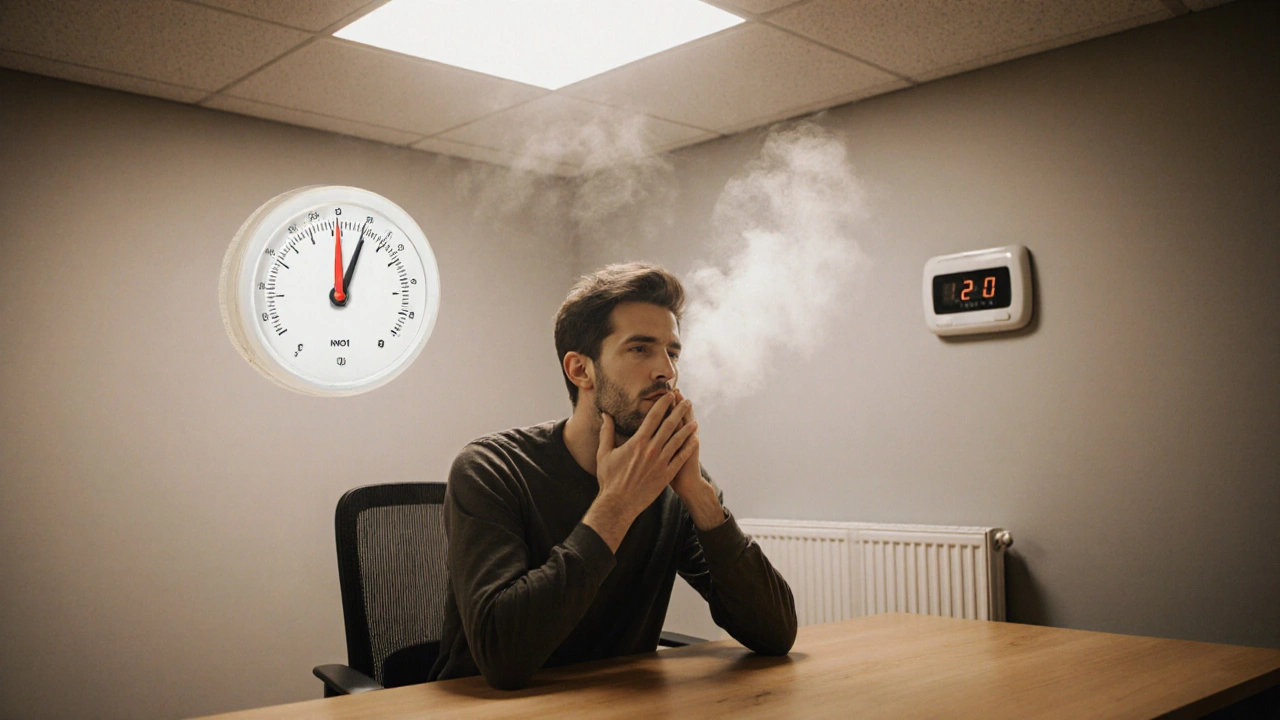Humidity Level Checker
Check if your indoor humidity is within the healthy range (30%-50%) and get tailored advice to protect your throat and respiratory health.
Ever noticed your throat feeling scratchy after a long day inside a heated or air‑conditioned room? That nagging irritation often isn’t just a coincidence - it’s a sign that the air around you is too dry, and the lining of your throat - the pharyngeal mucous membrane is the moist tissue that lines the back of the throat and protects the airway from particles and pathogens - is paying the price.
Why dry indoor air air with low moisture content found inside heated or air‑conditioned spaces dries out the throat
The mucous membrane relies on a thin film of water to keep its cells flexible and to trap dust, pollen, and microbes. When dry indoor air drops below a comfortable level, the water evaporates faster than the body can replace it. This leads to a thinner mucus layer, making the membrane more vulnerable to irritation, micro‑abrasions, and infection.
How low relative humidity the percentage of water vapor present in the air compared to the maximum it could hold at that temperature becomes a problem
Most health agencies recommend keeping indoor relative humidity between 30% and 50%. Below 30%, the air is considered “dry.” In winter, central heating can push humidity down to 10‑15% in some homes. In summer, aggressive air‑conditioning can have a similar effect, especially in humid climates where the system removes moisture to cool the air.
Typical symptoms you might notice
- Persistent tickle or raw feeling in the throat
- Frequent need to clear the throat
- Hoarseness, especially after speaking for a while
- Dry cough that worsens at night
- Difficulty swallowing solid foods without a mild pain
If these signs appear alongside a sore throat that lasts more than a week, it’s worth checking whether the indoor humidity is the culprit.

Beyond the throat: other health impacts of dry air
When the pharyngeal membrane loses moisture, it creates a domino effect throughout the respiratory tract. Dry air can:
- Increase the risk of viral infections like the common cold by compromising the first line of defense.
- Exacerbate allergic rhinitis an allergic inflammation of the nasal passages because allergens settle on dry surfaces and become easier to inhale.
- Worsen symptoms of asthma, as dry air can trigger bronchial spasms.
- Lead to skin dehydration, especially around the face and hands.
Why indoor humidity drops in the first place
Several everyday factors pull moisture out of the indoor environment:
- Heating systems devices that raise indoor temperature, often using forced‑air furnaces draw water vapor into the exhaust.
- Air conditioners machines that cool indoor air by condensing moisture onto coils actively remove water to lower temperature.
- Insufficient ventilation - closed windows and doors trap dry air inside.
- Winter outdoor air is naturally low in moisture; bringing it inside without humidification compounds the problem.
Simple ways to raise humidity back to a healthy range
Before you rush out to buy a fancy gadget, try these low‑cost tactics. Many work well alone; combine a few for best results.
- Place a bowl of water near a heat source - the water will evaporate gently.
- Use houseplants such as Boston ferns or peace lilies; they release moisture through transpiration.
- Hang wet towels in the room during a heating cycle.
- Ventilate briefly each morning by opening windows for 5‑10 minutes; outdoor air, even if dry, can bring in fresh particles that balance humidity.
- Keep the thermostat at a moderate temperature; higher heat dries air faster.
Choosing the right humidifier an appliance that adds moisture to indoor air, often using ultrasonic or evaporative technology
When natural methods don’t cut it, a humidifier becomes the most reliable fix. Here’s what to look for:
| Type | How it works | Pros | Cons |
|---|---|---|---|
| Ultrasonic | Vibrates a diaphragm at high frequency to create a fine mist. | Quiet, energy‑efficient, quick humidity boost. | Can release mineral dust if water isn’t filtered. |
| Evaporative (cool‑mist) | Air passes through a wet wick; water evaporates naturally. | Self‑regulating - doesn’t over‑humidify. | Can be noisier, requires regular wick replacement. |
| Steam (warm‑mist) | Boils water to release steam. | Kills bacteria, good for colder rooms. | Consumes more electricity, hot surface risk. |
For most households, a small ultrasonic unit rated for 200‑300sqft is enough. Choose a model with a built‑in hygrometer so you can monitor humidity and avoid exceeding the 50% ceiling.

Maintenance tips to keep your humidifier safe
Even a well‑chosen humidifier can become a source of mold or bacteria if you skip cleaning.
- Empty the tank daily and let it dry completely.
- Use distilled or demineralized water - it reduces mineral buildup.
- Wipe the base with a 1% vinegar solution weekly.
- Replace filters or wicks as per manufacturer advice (usually every 1‑3 months).
- Check the built‑in hygrometer weekly; adjust settings if you notice condensation on windows.
When to see a health professional
If you’ve raised humidity to the recommended range and still experience persistent throat pain, consider these red flags that warrant a doctor’s visit:
- Fever above 38°C (100.4°F)
- Severe difficulty swallowing or a sensation of food sticking
- White patches on the tonsils (possible strep infection)
- Persistent hoarseness lasting more than two weeks
- Worsening asthma symptoms despite inhaler use
A clinician can rule out infections, reflux, or structural issues that dry air alone can’t explain.
Quick checklist for a healthier throat
- Measure indoor humidity; aim for 30‑50%.
- Hydrate - drink at least 1.5L of water daily.
- Use a humidifier or natural moisture sources if humidity is low.
- Keep nasal passages clear with saline sprays.
- Limit caffeine and alcohol, which dehydrate tissues.
- Schedule regular humidifier cleaning.
- Consult a doctor if symptoms persist beyond a week.
Frequently Asked Questions
How low can indoor humidity get in winter?
In poorly insulated homes, heating can drop humidity to as low as 10‑15%, which is well below the comfort threshold and enough to irritate the throat.
Can a humidifier help with allergies?
Yes. Proper humidity helps keep dust and pollen from becoming airborne, and moist mucous membranes trap allergens more effectively.
What’s the risk of over‑humidifying a room?
Exceeding 60% can promote mold growth, dust‑mite proliferation, and a feeling of stuffiness, which can worsen respiratory issues.
Is distilled water necessary for humidifiers?
Distilled or demineralized water reduces mineral dust and scaling, extending the life of the device and keeping the mist cleaner.
How often should I replace a humidifier filter?
Most manufacturers suggest replacement every 1‑3 months, depending on usage and water quality. Check the indicator light if your model has one.


Michelle Morrison
One cannot simply ignore the covert operations of the HVAC industry, which deliberately designs indoor climates to keep us dependent on their products. The dry air you experience is not a natural inconvenience but a calculated strategy to increase sales of humidifiers and medication. This hidden agenda aligns with the broader narrative of corporate control over our health.